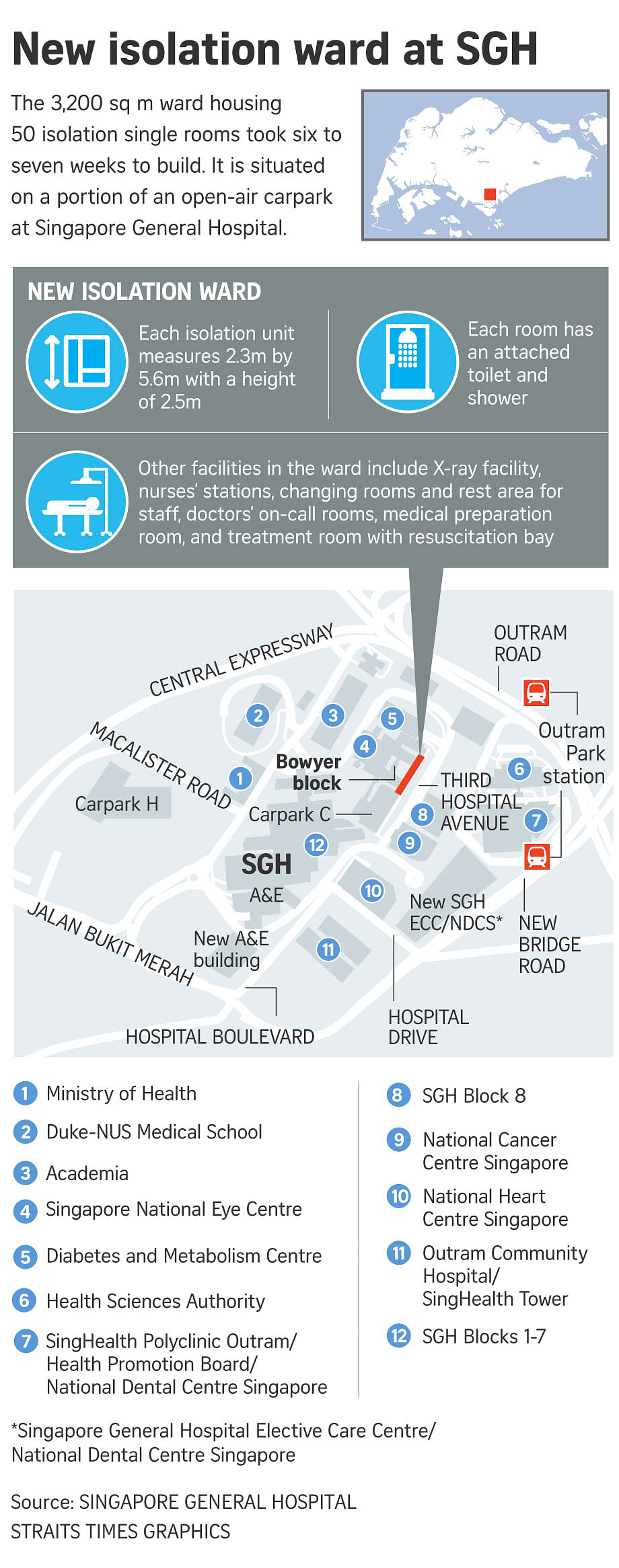New isolation ward more than doubles isolation rooms in SGH
Sign up now: Get ST's newsletters delivered to your inbox
A new isolation facility at Singapore General Hospital that comprises 50 isolation rooms will start admitting confirmed and suspected Covid-19 patients from Wednesday (July 15).
Follow topic:
SINGAPORE - A new isolation facility built on a portion of an open-air carpark in Singapore General Hospital (SGH) will add 50 isolation single rooms to the hospital's existing 35 to support the country's fight against Covid-19.
The facility will start admitting confirmed and suspected Covid-19 patients from Wednesday (July 15). It will also admit patients with other infectious diseases such as tuberculosis and measles.
Named Ward @ Bowyer as it is located adjacent to SGH's Bowyer Block, work at the 3,200 sq m facility started in mid-May during the circuit breaker period and was completed in about six to seven weeks.
The existing isolation ward for infectious diseases in SGH - Ward 68 - has 35 single rooms and 16 beds in non-single rooms.
Some of about 300 Covid-19 patients in SGH during April and May had to be roomed in other wards, said SGH Medical Board's chairman, Associate Professor Ruban Poopalalingam.
Of the 100 or so Covid-19 patients now in SGH, some - including incoming patients - will be sent to Ward @ Bowyer.
The hospital also sees 40 to 50 suspected Covid-19 patients each day.
The new ward is part of the national plan to increase capacity for Covid-19 cases, added Assoc Prof Poopalalingam.
"This ward is not built as a permanent fixture for the long run, we are not talking about decades. It was really designed for Covid-19 and we don't know how long the pandemic will last. It is built to at least last the distance of the pandemic and hopefully beyond for other infectious diseases."
Ward @ Bowyer is built to last a few years, he said.
"But we are happy with the increase in capacity of isolation rooms because (the ward) can be used beyond the Covid era. Apart from the National Centre for Infectious Diseases, there is not a lot of these infectious diseases isolation rooms in the country."
The patients who are sent to Ward @ Bowyer must be ambulant, able to take care of themselves and less likely to see their condition deteriorate.
Each negative pressure container-like isolation room measures 2.3m by 5.6m with a height of 2.5m and includes an attached toilet and shower. The ward is also elevated to allow for sewage, water and other pipes.
The medical team will use contact-free monitoring to detect warning signs of patient deterioration and will thus be able to intervene early.
For instance, patients will be given a biosensor to wear on their wrists which will allow their heart rate, respiration rate and oxygen saturation level readings to be wirelessly transmitted to clinicians.
The patients' vital signs will also be sent to a mobile app which they can access through the in-room smart phones.
If the patients are unwell or need assistance, they can use the in-room smartphone to contact the medical team either through video conferencing or through an app called MyCare Lite, which was developed by SGH's Nursing Division and the Integrated Health Information Systems, the Ministry of Health's IT arm.
By leveraging technology, the medical team can efficiently monitor and interact with patients without unnecessary risk of exposure, said SGH.

The smartphone also contains pre-loaded games for patients to pass the time, as well as reading materials about Covid-19 and coping with isolation.
Each isolated patient, who needs to be masked at all times, will be given an admission pack containing surgical masks, a digital thermometer and toiletries, and a care pack filled with drinks and snacks.
The ward also contains a specially designed container-like X-ray facility, which makes sure the patient will not come into contact with the radiographer.
The facility measures 6m by 2.4m, with a height of 2.6m.
The patient will stand in a transparent isolation booth pressed against the X-ray plate while the radiographer operates the X-ray machine a few feet away outside the booth. The radiographer will need to wear just an N95 mask, instead of the full personal protective equipment (PPE).
After every use, the isolation booth will be disinfected by a healthcare assistant geared in PPE.
The X-ray facility, named SG Safer, was designed by the hospital's Department of Diagnostic Radiology and cost between $6,000 to $8,000 to build.

